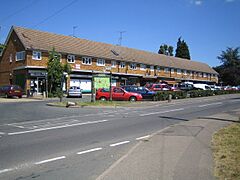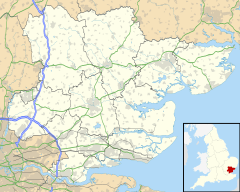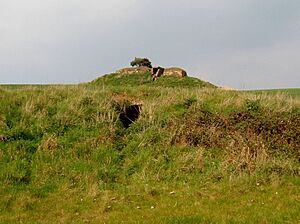Nazeing facts for kids
Quick facts for kids Nazeing |
|
|---|---|
 Nazeingbury Parade, Lower Nazeing |
|
| Population | 4,267 |
| OS grid reference | TL42250622 |
| Civil parish |
|
| District | |
| Shire county | |
| Region | |
| Country | England |
| Sovereign state | United Kingdom |
| Post town | Waltham Abbey |
| Postcode district | EN9 |
| Dialling code | 01992 |
| Police | Essex |
| Fire | Essex |
| Ambulance | East of England |
| EU Parliament | East of England |
| UK Parliament |
|
Nazeing (pronounced NAYZ-ing) is a village in Essex, England. It's part of the Epping Forest area. The village is actually made up of three smaller parts: Upper Nazeing, Middle Nazeing, and Lower Nazeing. About 4,267 people live here. The Prime Meridian, an imaginary line that divides the Earth, passes just west of Lower Nazeing.
Contents
Exploring Nazeing's Location and Landscape
Nazeing is about four miles north of Waltham Abbey. It's also about one mile southwest of Harlow. The River Lea forms its western border. Most of Nazeing is still countryside. However, over the last 40 years, there has been growth in market gardening. This means growing fruits and vegetables to sell. There's also been an increase in light industry, fishing for fun, and boating.
The land in Nazeing gently rises from the river. It goes up to a small hill and a bowl-shaped area. This area is about 270 feet above sea level in the east. The soil is mostly London Clay. Nazeingwood Common covers much of the eastern plateau. This common was once part of Waltham Forest. In the 1200s, it was cleared for animals to graze. It was also ploughed for farming during World War Two. A small stream runs west through the middle of the area from the common.
Nazeing's Past: A Look Back in Time
Early History of Nazeing
People have lived in Nazeing for over 2,000 years. We know this because old pot pieces from the Iron Age have been found. Roman burials were also discovered near the river in Nazeing Mead. The first Saxon settlement was likely in the eastern part of the area, near the church. This old village, now called Upper Park Town, might have given Nazeing its name. The name means 'settlers on a spur of land'.
The Old English word nœss means a headland, like a nose. The ending -ing means "the dwellers at". So, Nazeing means "People of the Headland". Early Saxon settlements were called hams. Later, more spread-out communities were named with -ing. Waltham was settled around 600 A.D. This suggests Nazeing was settled sometime in the 600s. The area around Nazeing Primary School was once known as the Ham fields. This might be where the first settlement in Nazeing was located.
The Domesday Book is a famous survey from 1086. It mentions Nazeing, or Nasinga. It records that the village had seven villagers, 12 smallholders, and one free man. They also had seven cattle and 30 pigs.
In 1848, a guide called White's Directory of Essex described Nazeing. It said Nazeing was a pretty area with scattered houses. It stretched three miles east from the River Lea. Another guide from 1870–72, Wilson's Imperial Gazetteer, also described Nazeing. It noted the village had 763 people and 165 houses.
Nazeing During World War One
Nazeing played its part in the First World War. A total of 153 men from the village joined the armed forces. Sadly, 28 of these men died. The village has four war memorials to remember them.
Nazeing During World War Two
During World War Two, Nazeing Common was used as a fake airfield. This was a trick to fool enemy planes. It was designed to look like the real North Weald airfield nearby. The lights on the fake airfield were placed on wooden poles of different heights. This made it look realistic from the air. These fake airfields started in June 1940. However, it's thought the Germans figured out Nazeing was a decoy by December that year. The site probably closed by July 1941. This was because the land was needed for farming. The decoy was built on common grazing land. This land was then ploughed for crops in August 1941.
Nazeing's Community Life
Nazeing is known as one of the largest villages in the UK. It has its own local government, called a Parish Council. This council helps manage local services and issues.
The village has two Anglican churches. One is the modern Saint Giles Parish in Lower Nazeing. The other is All Saints' Church, which is much older. There is also a Congregational Church on Middle Street. This church was started in 1795.
Nazeing has several pubs where people can meet. These include the King Harolds Head, Sun Inn, Black Swan, and the Crooked Billet.
The old Ponds petrol station at Nazeing crossroads was bought by the Parish Council in 2006. There were plans to turn it into a community hall. However, these plans were stopped in 2013 because the costs became too high. In 2014, the site was put up for sale. The Parish Council gave permission for six houses to be built there.
Interesting Places to See in Nazeing
Along the road to Nazeing Common, you can see several old cottages. The old post office is also there. All these buildings are listed as Grade II, meaning they are historically important. Lodge Farm, which stands alone on the edge of the common, was built in 1777.
Nazeing has the most listed buildings in the Epping Forest District Council Conservation Areas. There is one Grade I building and over 50 Grade II listed buildings. This includes at least one K6 Telephone Kiosk. This is a classic red telephone box. The parish church, All Saints, is in Betts Lane. It dates back to the 1100s and is listed as Grade I.
Nazeing Park: A Historic Mansion
Nazeing Park is a large Georgian mansion. It is a Grade II listed building. You can see it from Nazeing Common Road. It was built between 1780 and 1820 by William Palmer. He was a merchant from London. The building has been used for many things over the years. It was a family home and even a special school for children with difficulties.
World War II Bunkers: Hidden History
There are also World War II bunkers in Nazeing. These are listed by English Heritage. They are still in good condition. These bunkers were built away from the fake airfield. This was to protect the RAF crews who worked there. These buildings held generators to power the lights. They also had an operations room where the lights were controlled. People could also talk to the main station at North Weald by phone. Another bunker, about 100 feet down the hill, was used for shelter. It was a general area for sleeping and cooking.
As mentioned, this site was used from June 1940. The Germans likely found out it was a decoy by December. The site probably closed by July 1941. This was because the land was needed for more farming. The land was ploughed in August 1941. You can find these bunkers north of the Nazeing Brook, near Lodge Farm.
Clayton Hill: A Park for Everyone
Clayton Hill is a park in the Lee Valley. It has a lovely lake and a big hill. Many people who walk their dogs enjoy coming here. It's also a popular spot for villagers to meet up and spend time together.
Work and Business in Nazeing
For most of its history, Nazeing was a farming area. Agriculture was the main job. The River Lea to the west and the forest to the south also offered work. During World War II, Nazeing became very important. It was part of the Lea Valley, which provided a lot of fresh salad produce for the country. The Lea Valley also had many factories. These factories repaired aircraft, made furniture, and produced farm fertilizers. There were also power stations and breweries. Some of these were located in and around Nazeing. In the last forty years, market gardening and light industry have grown a lot near the river.
Hillgrove Business Park
Nazeing is home to Hillgrove Business Park. This is a medium-sized industrial area. It has more than 30 different companies.
Market Gardening and Nurseries
The Lea Valley, especially around Nazeing, is known for market gardening. This means growing plants, fruits, and vegetables to sell. It's also known for nurseries and garden centres. This industry used to be very big in the area. It also led to other businesses, like Pan Britannica Industries. In the 1930s, the Lea Valley had the most greenhouses in the world. Today, in many parts south of Cheshunt, houses have replaced the greenhouses.
Nazeing Glass Works
Glass making started in Nazeing in 1928. The Kempton family moved their small glass factory here from London. Nazeing Glass Works is one of the oldest glass makers still operating in the UK. Its history of glass making goes back to 1612 in Vauxhall. The company Nazeing Glass Works Limited was officially formed in 1931. In 1956, it had several furnaces for making glass.
Gravel Extraction and Leisure Lakes
Another major use of land in the area is digging for gravel. This has been done for many years by companies like Redland Gravel Company. You can see the results of this digging all over the area. There are many flooded gravel pits, which are now lakes. Many of these lakes have been turned into fun places for leisure. They are used for water sports and by sailing clubs. People also enjoy fishing in these lakes.
Learning in Nazeing: Schools and Education
Nazeing has its own primary school. Nazeing Primary School is a Community School for children aged 4 to 11 years. Essex County Council manages it. The school is for both boys and girls. In 2014, it had 254 students. Children come to the school from Nazeing and from nearby towns like Harlow and Waltham Abbey.
Nazeing Pre-School is for 3- and 4-year-old children. It is checked by Ofsted, which makes sure schools are good.
Fun and Games: Sport and Leisure in Nazeing
Nazeing has a golf course and a gym. It also has several youth football teams. These teams play at Bumbles Green Leisure Centre.
Nazeing Common Cricket Club was started in 1883. The club currently has two teams that play on Saturdays and two teams that play on Sundays.
There are many places to go fishing in and around Nazeing. For example, Nazeing Meads is managed by the Lee Valley Regional Park Authority.
Nazeing also has good facilities for water sports like sailing. Some of these activities use the lakes that were formed from old gravel pits. For instance, the Broxbourne Sailing Club is located in Nazeing. It uses the lakes created by past gravel digging.
Redwings Horse Sanctuary is a special place. The Ada Cole Rescue Centre in Nazeing is home to about 70 horses, ponies, and donkeys. It is open to the public. In 2005, Redwings joined with the Ada Cole Memorial Stables. This rescue centre was created to remember a lady who worked for animal welfare.
Famous Faces from Nazeing
- John Eliot (1604–1690) lived in Nazeing as a boy. He was known as the 'Apostle to the Indians' in Massachusetts. He translated the entire Bible into the Algonquian language. He also started the Roxbury Latin School.
- Ron Hickman (1932–2011) was an inventor and car designer. He designed the famous Lotus Elan car. He also invented the "Workmate," a popular workbench. He lived in Nazeing for a while around 1971.
- Chris Mathison (1926–2008) helped create the idea of self-service petrol stations. His business was a pioneer in this. The station at Nazeing crossroads is thought to have been the first self-service garage in the country.
- Murray Anderson (born 1940) is known for his connection to Cliff Richard. The famous singer Cliff Richard lived in Nazeing for a time. He bought a house called Rookswood in 1963.
- Mark Bristow (born 1962) was born in Nazeing. He is a double cycling Paralympic champion. He retired from the GB Para-Cycling Team in 2011 after six successful years.
- BJ Barry is a businessman and inventor. After his father, Billy Smart Jr., passed away, BJ Smart bought The Nazeing Park estate. His family founded Windsor Safari Park, which is now Legoland Windsor.





